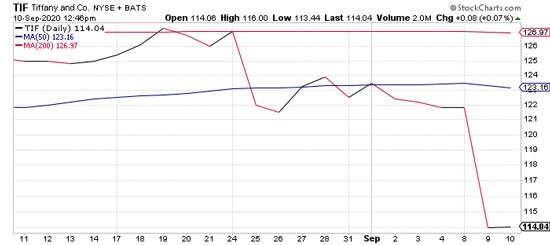How To Profit From A $16.2 Billion Luxury Loser
Well, it was fun while it lasted. For a few weeks now, the market has been buzzing about the "inevitable" acquisition of luxury brand Tiffany & Co. (TIF) by Bernard Arnault's luxury juggernaut LVMH Moet Hennessy Louis Vuitton SE (LVMUY).
To hear the media talk about it, it sounded like a done deal – a dead certainty. Nothing could stop it. The $16.2 billion deal would have been the biggest acquisition in the high-flying luxury sector's history. Of course I say "would have," because it all just fell apart. The sound of corporate wedding bells has been replaced by the shouts of corporate lawyers.
How a Good Deal Went Bad
On Wednesday, September 9, LVMH announced it was withdrawing its offer, and Tiffany turned right around to announce a lawsuit to try and force the mega-deal through. There had been some suspicion that LVMH was going to try and pull something, because the pandemic has hit the jewelry niche like a ton of bricks, but from where I stand, the real force driving the collapse is the French government.
France – perhaps looking forward to a change in Washington, D.C. come January 20 – requested LVMH to hold off on closing the deal until after January 2021, because of the threat of U.S. tariffs on French goods. France has already slapped American firms Alphabet Inc. (GOOGL), Amazon.com Inc. (AMZN), and Facebook Inc. (FB).

It's complicated. It's ugly. It could get worse. But that's fine with me, because where investors are seeing catastrophe, I'm seeing a beautiful trade setup. As you can see from the chart, which looks an awful lot like something fell off a cliff, Tiffany shares fell off a cliff. To say they gapped down is probably the understatement of the month.
Investors are clearly spooked. I think it's because they look at the collapse of this deal and see the prospect of a tariff-driven trade war between the United States and European Union; they're clearly seeing parallels between this and the China-U.S. trade war. They're imagining the disaster that would follow if countries start shutting off their markets to American companies.
And when investors get spooked about trade, which is basically what's happening here, I like making this following move.
Here's How to Play the Situation
The smart move is to buy puts on the SDPR S&P 500 ETF (SPY) – it's like playing the entire S&P 500, but for 10 times less money.
Specifically, I like out-of-the-money (OTM) puts, where the share price hasn't hit the strike price. That means the option has no intrinsic value yet, which, in plain English, means it's cheap -- at the moment. Why am I concerned with cost? Well, it's always a good idea to be cost-conscious when you're trading, but right now, it's even more important. With the volatility we're seeing on the S&P 500 currently, options premiums, particularly for puts, are, frankly, pretty stiff.
Heightened uncertainty is forcing traders to pay through the nose, which is making straight-up buying an option less appealing in the risk vs. reward department.
The easiest, cheapest, and all-around safest way to profit is to do a spread trade. You buy one option and sell another in the same transaction, which helps defray the pricey premiums and makes the risk vs. reward ratio much sweeter.
Here's the spread:
- Buy to open a SPY December 18, 2020 $320 put.
- Sell to open a SPY December 18, 2020 $310 put.
Your total debit is $2.50 per contract, or $250. Fifty percent is your maximum possible profit, and $250 is your maximum possible loss. If you flat-out bought the $320 put, you'd have to pony up more than $1,000, and your maximum possible loss would be pretty much unlimited.
See how much more sense it makes to do a spread here – or anytime options get expensive? It's easy to exit, too, when you hit your profit target. Simply sell what you bought and buy what you sold to close it out.
Disclosure: None.



